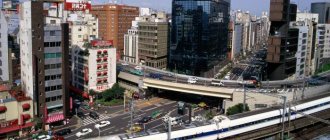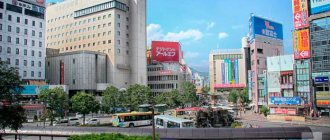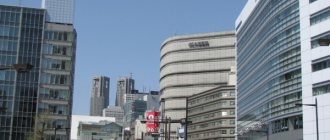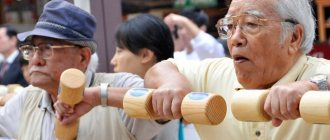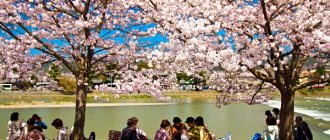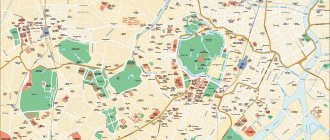Tokyo is one of the world's largest capitals with an agglomeration of 37 million people and one of the highest population densities in the world. This amazing city combines all the most modern that exists today in technology, and antiquity, which seems frozen on some streets of the capital of Japan.
We will look in more detail in the article about how the population of this largest Asian city has changed and what nationalities represent the composition of citizens today.
Greater Tokyo
Number
Tokyo is not only the capital of Japan; in addition, this agglomeration is one of the 47 prefectures of this state. As of 2021, the prefecture's population was 14 million. And by May 1, 2021, it had already reached 14,002,973 citizens. Such figures brought this metropolis to first place among the largest cities with an agglomeration.
Tokyo Prefecture (
Metropolitan Area
)
Statistics of the 17th century
The first data on the number of residents of the capital date back to 1644, by which time the population of Edo was 150,000 people.
The shogun is primarily a military leader. Men gladly flocked to his court in order to get a job, which, by the way, brought considerable profit at that time. By this year, their homes occupied 77.5% of the city’s space, churches - 10.2%. Commoners were allocated only 9.8%, although their number was no less than the number of people with weapons. And so it happened; they are still saving on space for ordinary citizens to live. In those ancient times, Edo was the dream city of brides. There were almost twice as many men living there as women. Thus, for every 100 grooms in 1733 there were only 57 potential brides, in 1844 there were already 90. And only by 1864 the situation leveled out, the number of women and men was equal.
There are no exact data on the number of residents at that time; no one cared about the census then. Scientific circles rely on approximate information, so by the end of the 17th century, the population of Edo was approximately 430 thousand people, and by 1853 there were already more than a million people in the city. By comparison, during the same period, the largest European capitals, London and Paris, could only boast populations of 700,000 and 500,000, respectively. People flocked to Edo (Tokyo) from the provinces to prove themselves, earn money, get married, get a job, and so on. Nothing has changed now. The metropolis attracts the Japanese with its lights and prospects. The population is growing hourly, which is why even official statistics are considered approximate.
Dynamics by year
Interestingly, the population of Tokyo in 2021, including its suburbs, is 38,140,000 people. This number of people live in the so-called Greater Tokyo. And this amounts to more than 20% of the total number of Japanese, because the total population of Japan in 2021 was 125,961,625 citizens. Thus, every 5 Japanese live directly in Tokyo and the suburbs of the country's capital.
If we analyze the change in this indicator over the years, here is what the numbers look like over the past few decades:
- 2000 – 127.4 million
- 2005 – 128.2 million
- 2010 – 128.5 million
- 2015 – 128.07 million
- 2020 – 126.6 million citizens.
Population of Japan
From these data it is clear that until 2015, the number of people living in this agglomeration increased, but in the last 5 years it has decreased slightly.
Foreigners in the city
The capital of Japan is a generally recognized international center. However, few foreigners live here. In 2005, only 3% of the total number was officially recorded. The capital of Japan has the largest population of Chinese. In 2008, more than 145 thousand people lived here. There are slightly fewer citizens of both Koreas - 117,567, more than 31 thousand Filipinos, about 20 thousand Americans. Hindus also organized their own community in Tokyo. About 190 thousand people live here. The number of Europeans is so small that it is not included in the statistics. In 2008, the prefecture spoke of 7,482 British citizens. Other nationalities are not mentioned in the reports.
Agglomeration
The city agglomeration includes 23 separate districts. Until 1943, they were directly part of the settlement, but now they are independent municipalities with their own mayor and council.
The Greater Tokyo Prefecture now includes:
- 26 separate cities.
- 1 separate county.
- 4 districts which include 8 fairly large settlements and 5 small towns.
Yokohama - a place of concentration of youth
Yokohama is the second most populous Japanese metropolis. It is the administrative center of Kanagawa Prefecture. It is the largest port city in Japan. Yokohama is highly developed economically, thanks to shipping, biotechnology, and electronics industries. The largest branches of commercial and industrial enterprises in Japan are located here. The area of the city is more than 400 sq km. Just like Tokyo, it is very densely populated.
Many young people stay here after graduating from higher education institutions and find employment. Yokohama is home to a prestigious university that provides quality education. It has high positions in the ranking of international universities. Specialists who have completed it are valued not only within the country, but also abroad. Also, residents of nearby settlements come here every day to work. Yokohama is a very modern, cosmopolitan city. Therefore, it attracts young people who want not only to make a career, but also to express themselves. Yokohama, just like Tokyo, has highways, high-speed trains, and a subway. Although there are fewer residents here, the average density is also very high. Therefore, there are often traffic jams on the roads, and there is a crush in the subway. It is better to book tables in restaurants in advance, as you may not find free seats in the evening. The transport problem is aggravated by tourists, a large number of whom arrive from different countries of the world all year round. Yokohama also has artificially created landfill areas. Coastal areas are being actively developed, and the territory of the seaport has expanded significantly. The Port of Yokohama is Japan's largest maritime hub.
Demography
Considering the demographic situation in Greater Tokyo, it is necessary to highlight the following figures:
- Despite how many people live in Tokyo, the standard of living is quite high. Thus, the average life expectancy is 82.3 years. The indicator differs between women and men – 85.7 and 79 years, respectively.
- If we consider what distribution among the total population of the city of Tokyo there is between the male and female population, then the coefficient here will be accordingly the following - 0.95. And, as in the vast majority of countries, the preponderance is towards the female population. Thus, in 2021, there are 64.8 million women for 61.6 million men.
- Considering the average age of the urban population in the Japanese capital and prefecture, it is worth noting that this figure today is 46.3 years. The figure indicates that the average age of a citizen of the Japanese capital is not too young. But it should be noted that the level of medical care, financial and social status are so high that they make it possible to ensure a high level of working capacity for the elderly category of the population.
- Looking at the age distribution, the picture for 2021 is as follows. Persons under 15 years of age make up 1.46 million people, that is, accordingly, 11.8%. In the age group from 15 to 64 years - almost 70%, which is equal to 8.6 million. But elderly people are a fairly significant proportion of the total number. In percentage terms it is 18.8%, and in numerical terms it is 2.3 million citizens.
Long-suffering
What else is characteristic of the city of Tokyo is that the population of the prefecture is very long-suffering. Throughout history, local residents have repeatedly become victims of natural disasters (volcanic eruptions and earthquakes). For example, in 1923 there was a powerful underground storm, which resulted in the death of 140 thousand people. The city itself was destroyed. The spring of 1945 became much more tragic, when Tokyo became the main target of American planes during bombing. The city's population then decreased by 250 thousand people, as a huge number of incendiary bombs were dropped on residential areas of the Japanese capital.
Ethnic composition
Despite the fact that the standard of living in Japan and Tokyo in general is quite high, the ethnic composition here is not very diverse. This is due to several factors simultaneously:
- The specificity of culture and lifestyle, which is not acceptable for many foreigners, especially those belonging to other cultures.
- The closedness of society itself.
- The difficulty of learning the language, which will not allow a foreigner to become a full-fledged member of society and assimilate among the Japanese.
In this regard, the national composition is presented as follows:
- The Japanese make up the majority of Tokyo's population - 98%.
- The remaining 2% are, in the vast majority of cases, nationalities such as Koreans, Chinese and some residents of other Asian countries. Other nations are represented to a lesser extent here.
Other indicators
The Japanese capital occupies a leading position on the planet not only in terms of the number of inhabitants. If we take into account the city itself (23 districts), then it is also the most densely populated on Earth. Tokyo's population density is more than six thousand people per square kilometer. This is due to the very high cost of local real estate. It is eloquent that the price of a plot of land, as a rule, is comparable to the amount of money that would be enough to cover it with a layer of gold. Compared to all other prefectures of the state, the smallest part of the territory is allocated for agricultural land - only 8,460 hectares. These lands can only partially satisfy the demands of the capital's residents for flowers, fruits and vegetables that are grown here. On the other hand, in such an indicator as GDP, the capital prefecture is second only to three countries - Germany, the USA and Japan itself as a whole.
Religions
As for religion, taking into account the specifics of the culture of the Asian region, the following movements are represented in the country:
- Atheists and those who do not identify themselves with any religion make up the overwhelming majority of 57%.
- Buddhists make up 36.2%.
- Representatives of other religions, which are not widespread enough, make up 4.6% of the country.
- Christians are a fairly small group, only 1.6%.
- Persons who consider themselves to be of different national religions are 0.4%.
- Islam is the least widespread - the number of citizens in Tokyo who identify themselves with this religion is 0.2%.
“Street standing” - what is it? And how does it relate to the population of Tokyo?
Traffic jams are a familiar sight for us. The population of Tokyo is off the charts, so during rush hours traffic turns into “street standing”. Absolutely everything freezes. Why is movement particularly constrained in the capital? Typically, in large cities, up to 33% of the city’s territory is allocated for roadways. But in this metropolis it is only 10%.
Tokyo is a real environmental disaster: there is a huge concentration of soot and too little greenery.
There is only one square meter of park per resident. ← Back to list of articles
Migration
Due to the fact that Japan has a fairly restrained attitude towards migration policy, the country is able to achieve the following positive indicators:
- Low crime rate.
- Preservation of national traditions that are not influenced by other cultures.
But at the same time, the country is also unable to resolve the issue of population aging by increasing migration flows. In this regard, it does not follow the path of Europe and America.
It will be possible to see how successful such a policy regarding migrants will be over the course of 15-25 years, when the proportion of the elderly population in the country will increase even more. But, at the same time, the homogeneous ethnic composition will remain.
But the government of the country has not yet been able to solve the problems with the birth rate. This is due to both the high pace of life and the desire of the young population to lead a reclusive lifestyle. Today, a specific culture has formed in Japan, where young people prefer to spend time at home, watching TV, playing computer games, rather than communicating live with their peers.
The mysterious country of Japan and its capital is the city of Tokyo. What is the population of the capital?
The country of Japan, the city of Tokyo - its capital, is a world of houses, with their chaotic heaps reminiscent of furniture that, during renovation, was pushed into a heap in one place until the time comes to put everything in its place. Imagine that due to such crowding on 600 sq. m live about 9 million Tokyo residents.
During rush hours there is a real crush on the streets of the capital. And the residents joke that their dogs are already accustomed to the fact that they can only wag their tail up and down, there is no other way.
Today, half of the country's citizens with higher education live in Japan, and half of the country's students also receive higher education. This giant magnet attracts young people with terrible force. The capital is a bundle of energy and a concentration of hopes.
At one time, the growth of the giant city became uncontrollable. Even experts cannot answer the question “how much is the population in Tokyo”, since the number is growing day by day. Experts believed that the deterioration of living conditions would lead to an outflow of people from the capital. However, today Tokyo represents 10% of the entire country's population and the same percentage of the workforce. And, despite forecasts, the city continues to grow.
How chaotically the houses are arranged, the flow of people looks so chaotically from afar. At the same time, a huge number of the population prefers to settle in neighboring prefectures, the suburbs of Tokyo. The reason for this is the extreme high cost of housing in the city. Because of this, traffic flow is overloaded.
The average Tokyo resident spends up to 4 hours traveling from home to work and back, which is at least half of a full working day. Can you imagine what it’s like to get to the airport? True, today Tokyo Haneda Airport, which is one of the two largest, is connected to the center of the capital by a monorail, which makes the journey much easier.
In Tokyo you will not find remarkable places from which you can begin a traditional description of the capital, as is done, for example, in the case of Paris and the Champs Elysees. The peculiarity of Japan and the city of Tokyo is not the megalopolis buildings stretching beyond the horizon, but the fact that the eye vainly searches for something to cling to: any architectural dominant that can become a fulcrum.
Even the Imperial Palace, where many Japanese emperors made the country's history, does not stand out from the general background. From the outside it is just a park surrounded by a moat.
Demographic situation
Demography studies the population, the patterns of its reproduction, distribution and composition. The fact is that Japan has low birth and death rates. CNN reports that the number of newborns fell to 921,000 in 2021, the lowest since 1899. Each woman gives birth to an average of 1.4 children, when with an increase in the population this figure is 2.1. The government intends to increase this number to 1.8. On the other hand, the mortality rate in Japan is also low. Since the country has developed healthcare and education for citizens, the Japanese can boast of almost the highest standard of living among the most developed countries. The standard of living also affects the average life expectancy , here the Japanese are ahead of countries such as Switzerland, Spain and Singapore (the world average is 71 years):
According to the census results at the beginning of 2019 , 126,048,221 people live in Japan (current as of April 2019). This allowed the country to take 10th place among other countries in terms of the number of citizens.
At the beginning 2020 , Japan's population dropped below 125 million and is 125,876,292 people (current as of June 2021).
Like throughout the world, 2021 turned out to be a very difficult year for Japan. Although it did not affect the country much, the population has decreased and at the beginning of 2021 : 125,620,000 people.
average life expectancy
- men – 79 years old
- women – 85.7 years
This means that Japan is an aging nation. The percentage of residents of retirement age is increasing (22.9%), and fewer and fewer are children and adolescents (only 13.1%). The remaining 64% of residents are of working age.
social burden is created in Japanese society . To provide for disabled people, it is necessary that able-bodied residents produce one and a half times more services and goods than they need themselves.
The ratio of men to women is:
- 0-24 – 105 men per 100 women
- 25-69 – 101 to 100 respectively
- 70+ – 69 to 100
